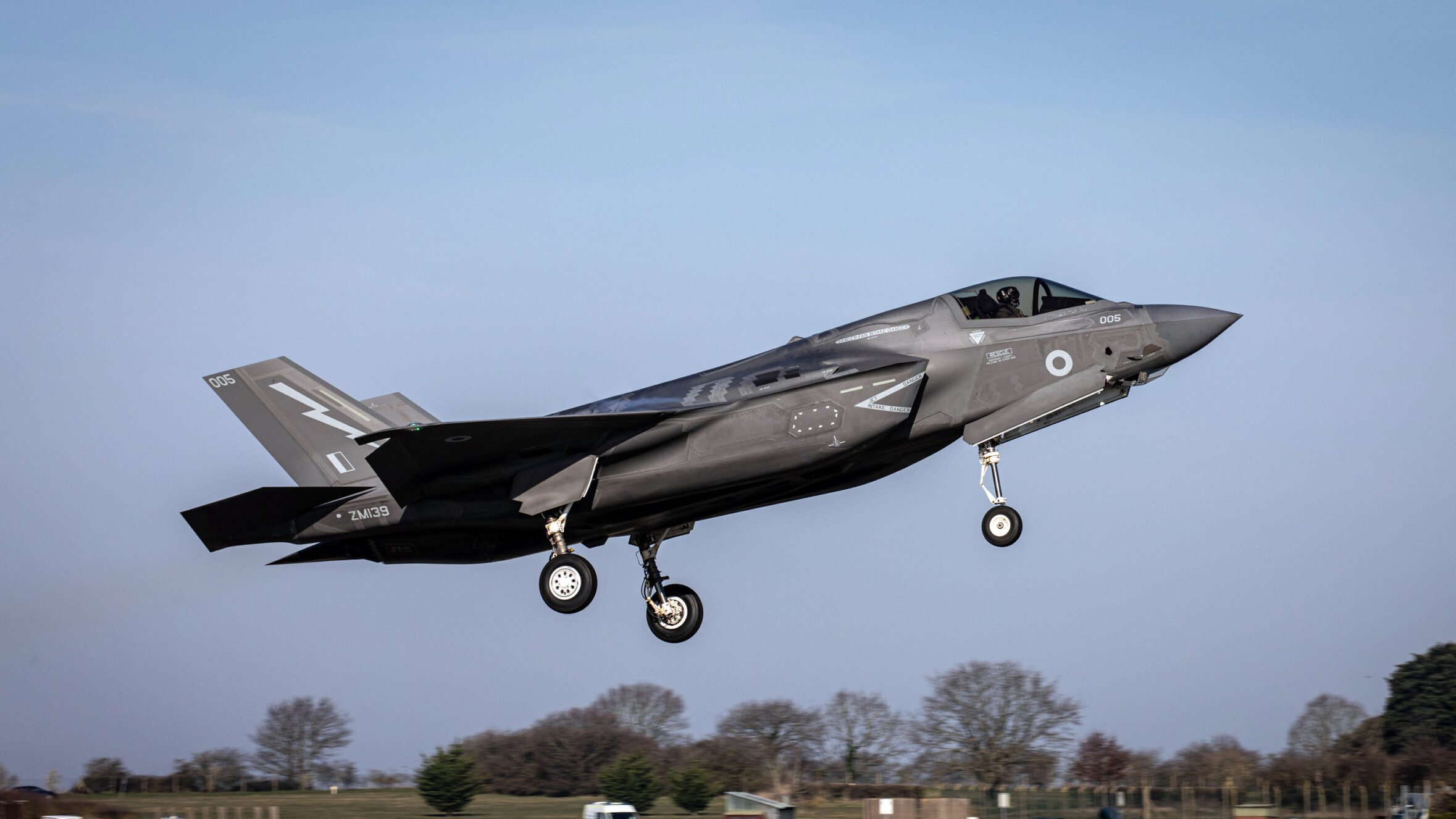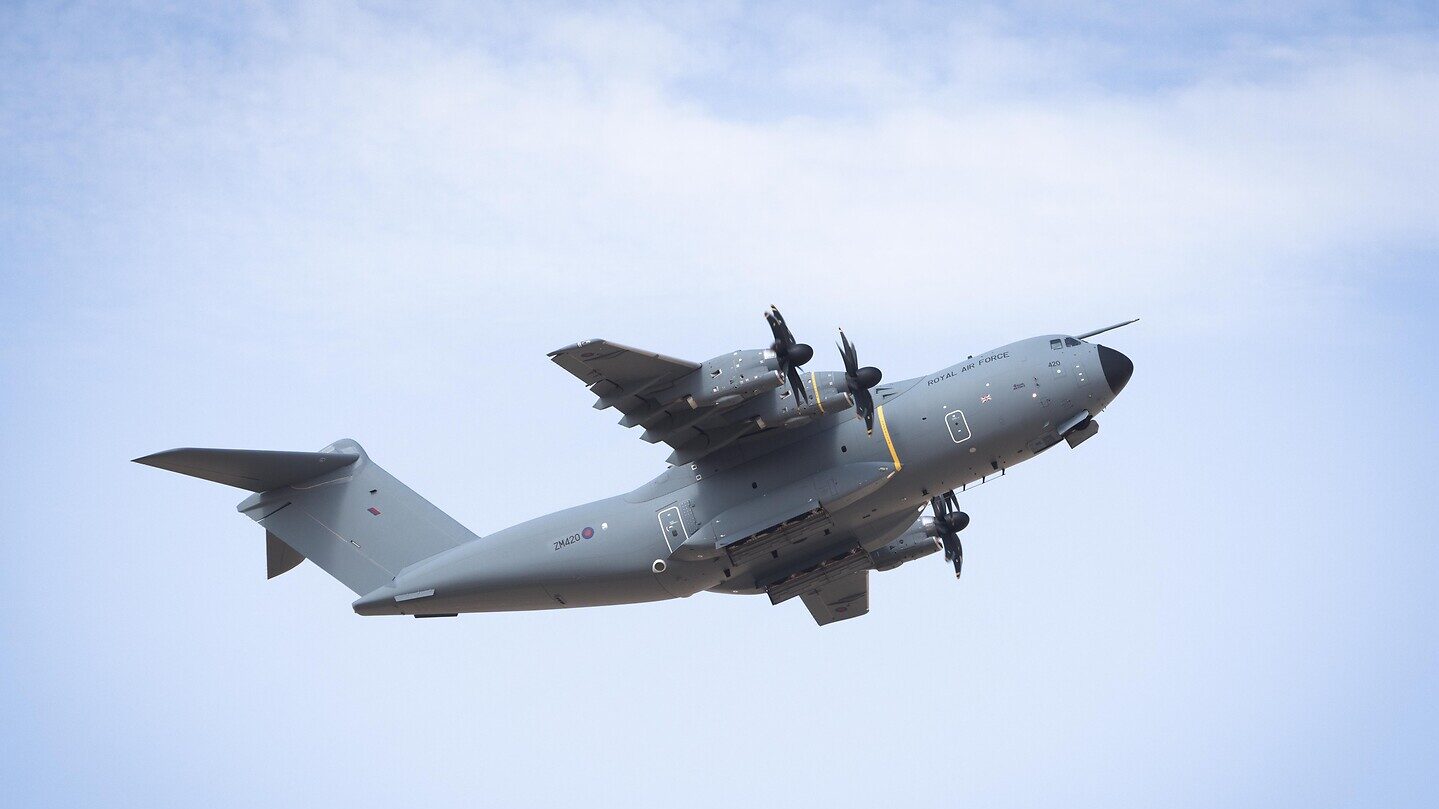
A F-35B Lightning jet from 617 Squadron takes off from RAF Marham to take part in an air maritime integration exercise (UK MoD)
Updated Dec. 5 at 8:04 am ET with comment from the UK MoD
BELFAST — In a rare joint appearance before lawmakers, top United Kingdom defense industry officials this week disclosed troubling issues affecting some of the Royal Air Force’s most expensive aircraft programs.
At the Defence Committee hearing Tuesday, a top Lockheed Martin executive, for instance, suggested the British government was purposefully delaying delivery of 47 F-35B aircraft, though it wasn’t immediately clear why. Separately, supplier issues have forced Boeing to delay E-7 Wedgetail Mk1 Airborne Early Warning and Control (AEW&C) aircraft deliveries from 2023 to 2024. That means the RAF faces a three-year fixed wing airborne early warning capability gap.
The Airbus A400M Atlas transport aircraft also suffered from a number of technical problems in 2022, which Airbus UK director of military affairs Sir Kevin Leeson referred to as a “regrettable collection of discoveries.” Those problems have been overcome, the company said, but on the same day a government watchdog revealed the MoD had ditched a plan to purchase extra A400Ms because it couldn’t afford them.
Taken together, the problems of the three aircraft acquisitions show how the RAF continues to struggle with generating new frontline capabilities in a timely manner and against a backdrop of menacing Russian and Chinese threats. Should issues with the E-7 in particular fester, the public will grow to wonder how well the British air force would be able to see an attack coming.
An F-35 Delivery Change, And A ‘Handshake’ On More
On combat air matters, the decision to slow the pace of F-35 deliveries was revealed by Paul Livingston, chief executive of Lockheed Martin UK.
“Just to be clear it’s not our deliveries that are slipping, it’s when the MoD are choosing to take their options in those [current] production lots,” he said. “That has been a change.”
Livingston offered no explanation about why the MoD made the decision, but “affordability” has since been clarified as the cause.
RELATED: Economic troubles could put UK in firing line for more defense takeovers
Those financial pressures have for some time led to analysts questioning if an original commitment to procure 138 of the fifth generation fighters will be honored. In his testimony, Livingston referred to the first batch of 48 fighters to be delivered.
“At the moment the UK has taken the decision to take its near-term purchases and spread them out further. That is part of the 48 already on contract, so those delivery dates have gone. We were expecting eight, eight and nine [UK aircraft] in the next three [production] lots, but it is nowhere near that,” he said.
A spokesperson for Lockheed Martin confirmed in a Dec. 1 statement to Breaking Defense that a total of 30 F-35B aircraft have so far been delivered to the UK with a further seven due for delivery in 2023. The remaining 11 will follow in 2024 and 2025, according to the spokesperson. The spokesperson did not share a specific delivery schedule for 2024 and 2025, but a breakdown of six and five aircraft per year would fit with Livingston’s assertion that the rate of delivery is being slowed down.
“As those lots get negotiated with less fees per lot, that may alter the price of the [F-35]B,” Livingston said of a second tranche UK order. “I can’t say to what extent it will alter the price because it will depend on volume and [orders from] other [F-35]B customers.”
Livingston also revealed that the MoD and Lockheed Martin UK have already made a “handshake agreement” on the follow on F-35 order, with the two parties specifically discussing production lots 15, 16 and 17 so far.
Despite the fact that London has faced severe financial problems with its F-35 procurement because of increases in US foreign exchange rates and rising costs for weapons integration, Livingston said that the recurring flyaway unit cost for the B variant had gone down by 51 percent since the start of the program and now stands at 39 percent less than the first UK delivery in 2012.
“The program cost is reducing not spiraling” he said.
Supply Chain Woes Push Wedgetail To 2024
Elsewhere, an average supplier lead time increase of 244 days for E-7 parts has led Boeing to delay a first aircraft delivery to RAF Lossiemouth, Scotland, until 2024. The new schedule change comes after the RAF admitted in October 2022 that an original target of initial operating capability for the new early warning aircraft of 2023 had been delayed until 2024, without further elaboration.
“Supply chain is one of the largest challenges [we face], I think it’s very important to note that when we first contracted the E-7 in 2019, together with the Ministry of Defense, we made the best assessment [regarding] schedule that we could, and no one could have predicted a global pandemic,” said Anna Keeling, managing director of Boeing UK. “That has been the biggest driver [on delivery schedule changes].”
The UK currently faces a significant airborne early warning capability gap after retiring the Boeing E-3D Sentry in 2021. The decision to cut the E-7 procurement from five to three aircraft on cost-saving grounds has also been a major source of contention politically.
OP ED: Congress is right: Accelerate the E-7 Wedgetail buy
All three of the aircraft are based in Birmingham, England, as they undergo conversion from 737 Next Generation commercial airframes to the E-7 standard.
Boeing announced on Nov. 4 that the first Northrop Grumman Multi-role Electronically Scanned Array (MESA) radar, had been installed after testing at the latter’s radar range in Linthicum, Md. The radar can detect targets “at increasing longer ranges,” according to Boeing.
As for the financial burden, in the hearing Keeling said that she was “not able to discuss” costs for the E-7 program as the MoD has still to sign off on the full business case, a key document that covers items like costs and schedule, expected to be approved in 2023.
“We were certainly set some cost savings to keep the program and that is what we are committed to delivering,” she explained.
Under the original order for five aircraft in 2019, Boeing and the UK agreed to a $1.98 billion deal, but there remains disquiet over E-7 project management issues. “It has sort of come to light that the budget for three aircraft is going to be not that dissimilar to the budget for five because of the gross underestimate of costs made by the MoD,” said Francis Tusa, a UK defense analyst.
Technical Issue ‘Discoveries’ Hit A400M
Turning to A400M developments, Leeson said that the “discoveries” or newer technical issues were “things that quite simply should not have gone wrong.”
“We had a little bit of difficulty in the summer with that but I’m now pleased to say we’re completely through it and borne the burden to ensure the customer is not prejudiced,” he said.
Leeson did not go into details of the technical problems but did admit that other outstanding issues for the program include lack of clearance for static line parachute jumping and a number of Special Forces “capabilities” still not delivered, “some” of which are the responsibility of the MoD, he explained.
As for the “difficulties,” an Airbus spokesperson told Breaking Defense this week, “Earlier in the year some corrosion was found in the landing gear bay on some aircraft of the UK fleet. We worked together with our customer and fixed the issue across the fleet.”

The UK has ordered 22 A400M Atlas transport aircraft but a “regrettable collection of discoveries” troubled the program this year (Airbus UK)
Still, that issue was the latest example of Airbus struggling with A400 technical and operational challenges that have ranged in the past from gearbox problems, public criticism by operators of poor availability rates and doubts continuing to persist over whether the aircraft can meet all capability requirements requested of it. The A400M is a different aircraft type to the Lockheed Martin C130J tactical airlifter it will replace in 2023, and it offers twice the payload, but it is understood to be disliked among UK Special Forces operators on grounds that it is less agile for landing.
Regardless, both the Airbus spokesperson and Leeson painted a more optimistic picture, with Leeson noting Airbus UK has managed to “deliver” over the agreed availability target for the A400M. Airbus announced on Oct. 11 that it had delivered 21 of 22 A400M on order for the RAF.
The program took another blow, however, on the same day as Leeson’s testimony when the National Audit Office’s (NAO) “Defence Equipment Plan 2022 to 2032” report said that the MoD will not purchase additional A400M aircraft after it judged an option to do so “unaffordable.” Instead, funding will be put toward “developing an affordable choice” to improve availability of the aircraft. The annual NAO report assess the MoD’s long term financial plans, addressing procurement program cost projections and other items like infrastructure and operations.
Beyond the A400, E-7 and F-35 program problems, Livingston also discussed the Crowsnest carrier-based airborne early warning rardar program and acknowledged that Lockheed “clearly” didn’t “understand the depths of problems” faced by subcontractor Thales. But that, too, had turned a corner, he said.
“I’m pleased to say that as of today and [based] on Carrier Strike Group 22 [feedback], the latest version 12.2 of the [Crowsnest] software is performing well,” he said. “It’s much more stable. The capability is coming along. It has taken too long. We regret that immensely.”
Lockheed Martin and other Crowsnest suppliers are also now in discussion with the Royal Navy to agree on additional “specifications” for the system, according to Livingston. He said, however, that an entry to service date for the radar could not be provided until those discussions close and the specifications approved.
Norway’s air defense priorities: Volume first, then long-range capabilities
“We need to increase spending in simple systems that we need a huge volume of that can, basically, counter very low-tech drones that could pose a threat,” Norway’s top officer told Breaking Defense, “so we don’t end up using the most sophisticated missile systems against something that is very cheap to buy.”


























